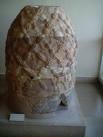
BAETYLUS, a word of Semitic origin (= bethel) denoting a sacred stone, which was supposed to be endowed with life. These fetish objects of worship were meteoric stones, which were dedicated to the gods or revered as symbols of the gods themselves (Pliny, Nat. Hist. xvii. 9; Photius, Cod. 242). In Greek mythology the term was specially applied to the stone supposed to have been swallowed by Cronus (who feared misfortune from his own children) in mistake for his infant son Zeus, for whom it had been substituted by Uranus and Gaea, his wife's parents (Etymologicum Magnum, s.v.). This stone was carefully preserved at Delphi, anointed with oil every day and on festal occasions covered with raw wool (Pausanias x. 24). In Phoenician mythology, one of the sons of Uranus is named Baetylus. Another famous stone was the effigy of Rhea Cybele, the holy stone of Pessinus, black and of irregular form, which was brought to Rome in 204 B.C. and placed in the mouth of the statue of the goddess. In some cases an attempt was made to give a more regular form to the original shapeless stone: thus Apollo Agyieus was represented by a conical pillar with pointed end, Zeus Meilichius in the form of a pyramid. Other famous baetylic idols were those in the temples of Zeus Casius at Seleucia, and of Zeus Teleios at Tegea. Even in the declining years of paganism, these idols still retained their significance, as is shown by the attacks upon them by ecclesiastical writers.
See Munter, Über die vom Himmel gefallenen Steine (1805); Bösigk, De Baetyliis (1854); and the exhaustive article by F. Lenormant in Daremberg and Saglio's Dictionary of Antiquities.
*******
Source: 1911 Encyclopedia
Copyright © D. J. McAdam· All Rights Reserved